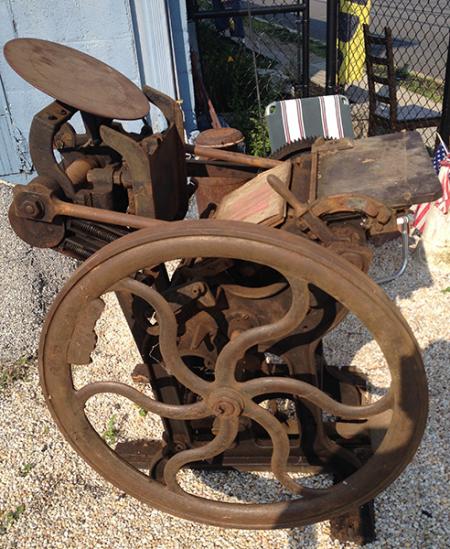Restoration suggestions
Well, I’ve come across this rusted relic nearby. It is pretty much 100% covered in rust.
It does turn, and doesn’t seem to be missing any super crucial parts (aside from a chase). It’s also missing the nameplate on the back, but I don’t think that will hamper functionality.
I’ve seen lots of different views on restoration, but I’d like to get some updated opinions if possible.
Soda blasting? Evapo-rust?
It doesn’t need to be a picture perfect fancy restoration, but I’d like to do the best I can within reason.

IMG_6917.jpg
You could just go after it with a wire wheel on an electric drill. It doesn’t look like there is much or any paint left, so you’re not going to hurt the finish. I’d give it a good oiling, work it a bit to get the oil into the joints, oil again, plug the oil holes with something like wax earplug material that can be removed intact afterwards, and have at it - without dis-assembly any further than simple stuff like the ink disc. Then paint it and print with it!
Bob
If you have resources and the ability, I would completely disassemble the press and clean every bearing surface and shaft for a start. A cup brush in a disc grinder makes for quick rust removal, but not on critical surfaces. I have use phosphoric acid (concrete etch) for large scale rust removal. No one chemical or mechanical technique will do for a complete project. Good luck.
Would seem to be several stages/options according to how far you can go, very least, (possibly) coat it liberally with ordinary Diesel Fuel, (fraction of the cost of All the freeing agents and 10 times as good) catch it in a drip tray or, soak up with rags to recycle!! Leave as long as poss, 2/3/4 days to *marinate* and then gently ” inch” m/c backwards and forwards, feeling for tight spots, implying shaft(s) reaching internal rusty points.!! No full revolutions at first.???
Having achieved full continuous revolutions pump more diesel and oil 50/50 mix into every moving part(s).
The preceding would only get to the point of attempting to print, maybe, but without a substantial strip down, (which may not be an option) although you would be printing, it would hurt to see, rusty/oily trails dribbling down the frame for weeks or more,! and the good possibility of increased wear from the trapped rust, especially on the *Axes* of the Platen, the Bed, and the substantial side con Rods, ? possibly think where, over the course of time, many little oil holes, have made natural water traps.???
If however a substantial renovation is envisaged, possibly, soak in Diesel, as above, then before attempting to shift any Nut, Bolt, Anti clockwise, (the natural/normal way) gently shift CLOCKWISE just a fraction, 2 fold exercise, (A) momentarily crushes inert rust, to give a fighting chance of undoing & (B) will give a feel/sense if the Nut/Bolt will undo without stripping or breaking, if it is felt that breakage is possible, play a D.I.Y. blowtorch on the Nut/Bolt for a few seconds, standard practice for our Engineers Fitters, Automotive and Graphics. 98% success, normally.??.
If and when stripped down, linnish/polish working surfaces of shafts, bolts etc looking for checking for wear, and fingers crossed, NO, replacements.
All main parts, shaft openings etc, protected/plugged with cork/plastic plugs etc etc later cleaned with rotary wire brushes, BRASS Bristles only.???
Everything else Blasted with Least abrasive method possible, i.e.your own Soda? Silver sand, or the most gentle but still very effective *crushed walnut shells* really does make a good job, in all the obscured spots Up & Under? of course with Face Mask & Eye shield.
Plus here U.K. before reassembly we ensure that ALL the oil holes are cleaned out, with no blind holes/shafts to worry about, + apparently silly move??? we countersink, the normally, countersunk *oil Holes* a little extra, to accomodate a modern squirt can, and with Shellac, or Quick drying Enamal, outline the holes, as would have been original, Yellow/Red, does help with or without access to original specs.
When we go this deep, after blasting, with whatever? everything is *masked up*, where appropriate, and then initially sprayed with *Acid Etch Primer* normally, U-POL in U.K. Absolutely perfect on Unfetelled Sand cast, printing machine parts, (which they generally were/are), plus *Acid Etch* being modern Hi-Tech, application, is in every way superior to old fashioned, *Red Lead or Red oxide*
Apologies for the “ramble” but may help to formulate a plan, to bring *him* back to life. Good Luck.